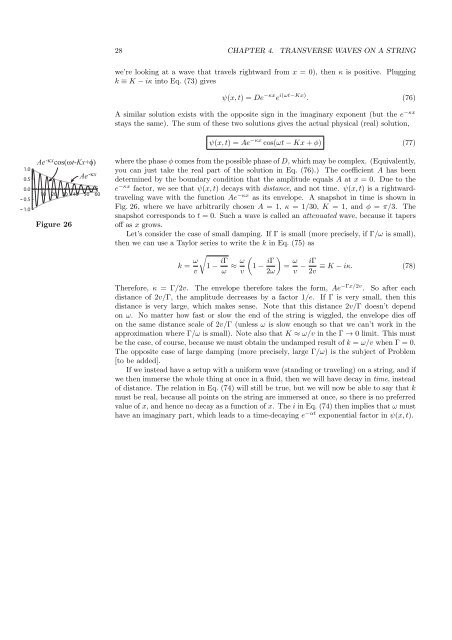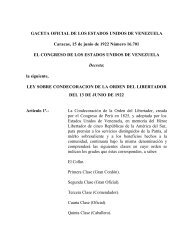Transverse waves on a string - People.fas.harvard.edu
Transverse waves on a string - People.fas.harvard.edu
Transverse waves on a string - People.fas.harvard.edu
You also want an ePaper? Increase the reach of your titles
YUMPU automatically turns print PDFs into web optimized ePapers that Google loves.
-<br />
-<br />
1.0<br />
0.5<br />
0.0<br />
0.5<br />
1.0<br />
Ae -κx cos(ωt-Kx+φ)<br />
10 20 30 40 50 60<br />
Figure 26<br />
Ae -κx<br />
28 CHAPTER 4. TRANSVERSE WAVES ON A STRING<br />
we’re looking at a wave that travels rightward from x = 0), then κ is positive. Plugging<br />
k ≡ K − iκ into Eq. (73) gives<br />
ψ(x, t) = De −κx e i(ωt−Kx) . (76)<br />
A similar soluti<strong>on</strong> exists with the opposite sign in the imaginary exp<strong>on</strong>ent (but the e −κx<br />
stays the same). The sum of these two soluti<strong>on</strong>s gives the actual physical (real) soluti<strong>on</strong>,<br />
ψ(x, t) = Ae −κx cos(ωt − Kx + φ) (77)<br />
where the phase φ comes from the possible phase of D, which may be complex. (Equivalently,<br />
you can just take the real part of the soluti<strong>on</strong> in Eq. (76).) The coefficient A has been<br />
determined by the boundary c<strong>on</strong>diti<strong>on</strong> that the amplitude equals A at x = 0. Due to the<br />
e −κx factor, we see that ψ(x, t) decays with distance, and not time. ψ(x, t) is a rightwardtraveling<br />
wave with the functi<strong>on</strong> Ae −κx as its envelope. A snapshot in time is shown in<br />
Fig. 26, where we have arbitrarily chosen A = 1, κ = 1/30, K = 1, and φ = π/3. The<br />
snapshot corresp<strong>on</strong>ds to t = 0. Such a wave is called an attenuated wave, because it tapers<br />
off as x grows.<br />
Let’s c<strong>on</strong>sider the case of small damping. If Γ is small (more precisely, if Γ/ω is small),<br />
then we can use a Taylor series to write the k in Eq. (75) as<br />
k = ω<br />
<br />
1 −<br />
v<br />
iΓ<br />
<br />
ω<br />
≈ 1 −<br />
ω v<br />
iΓ<br />
<br />
=<br />
2ω<br />
ω iΓ<br />
− ≡ K − iκ. (78)<br />
v 2v<br />
Therefore, κ = Γ/2v. The envelope therefore takes the form, Ae −Γx/2v . So after each<br />
distance of 2v/Γ, the amplitude decreases by a factor 1/e. If Γ is very small, then this<br />
distance is very large, which makes sense. Note that this distance 2v/Γ doesn’t depend<br />
<strong>on</strong> ω. No matter how <strong>fas</strong>t or slow the end of the <strong>string</strong> is wiggled, the envelope dies off<br />
<strong>on</strong> the same distance scale of 2v/Γ (unless ω is slow enough so that we can’t work in the<br />
approximati<strong>on</strong> where Γ/ω is small). Note also that K ≈ ω/v in the Γ → 0 limit. This must<br />
be the case, of course, because we must obtain the undamped result of k = ω/v when Γ = 0.<br />
The opposite case of large damping (more precisely, large Γ/ω) is the subject of Problem<br />
[to be added].<br />
If we instead have a setup with a uniform wave (standing or traveling) <strong>on</strong> a <strong>string</strong>, and if<br />
we then immerse the whole thing at <strong>on</strong>ce in a fluid, then we will have decay in time, instead<br />
of distance. The relati<strong>on</strong> in Eq. (74) will still be true, but we will now be able to say that k<br />
must be real, because all points <strong>on</strong> the <strong>string</strong> are immersed at <strong>on</strong>ce, so there is no preferred<br />
value of x, and hence no decay as a functi<strong>on</strong> of x. The i in Eq. (74) then implies that ω must<br />
have an imaginary part, which leads to a time-decaying e −αt exp<strong>on</strong>ential factor in ψ(x, t).

















